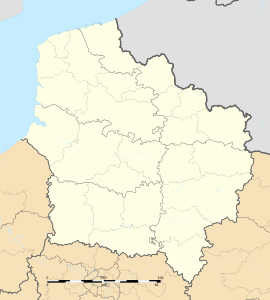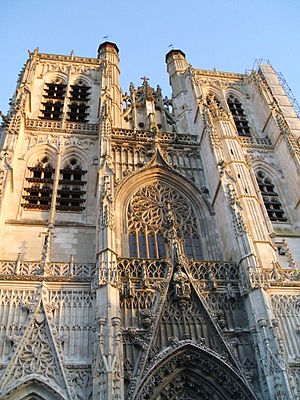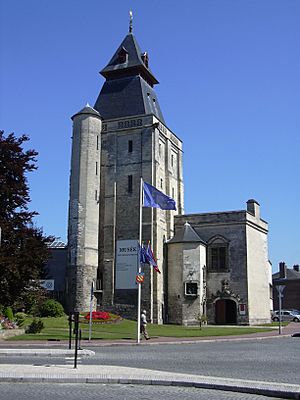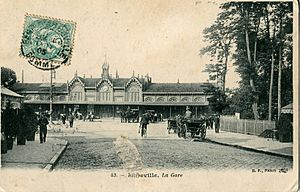Abbeville facts for kids
Quick facts for kids
Abbeville
|
||
|---|---|---|

Max Lejeune square
|
||
|
||
| Country | France | |
| Region | Hauts-de-France | |
| Department | Somme | |
| Arrondissement | Abbeville | |
| Canton | Abbeville | |
| Area
1
|
26.42 km2 (10.20 sq mi) | |
| Population
(2006)
|
24,829 | |
| • Density | 939.78/km2 (2,434.0/sq mi) | |
| Time zone | UTC+01:00 (CET) | |
| • Summer (DST) | UTC+02:00 (CEST) | |
| INSEE/Postal code |
80001 /80100
|
|
| Elevation | 2–76 m (6.6–249.3 ft) (avg. 8 m or 26 ft) |
|
| 1 French Land Register data, which excludes lakes, ponds, glaciers > 1 km2 (0.386 sq mi or 247 acres) and river estuaries. | ||
Abbeville is a town in northern France, located in the Somme area of the Hauts-de-France region. It's known for its rich history, from ancient times to World War II.
Contents
Where is Abbeville Located?
Abbeville sits right on the Somme River, about 20 kilometers (12 miles) from where the river meets the English Channel. Most of the town is on the east side of the Somme, and part of it is even on an island! It's also the starting point of the Abbeville Canal. The city is about 45 kilometers (28 miles) northwest of Amiens.
Hundreds of years ago, during the Middle Ages, Abbeville was the lowest point where people could cross the Somme River. An interesting historical fact is that King Edward III of England's army crossed the river near here just before the famous Battle of Crécy in 1346.
How Abbeville is Governed
Abbeville used to be the main city of an old French area called Ponthieu. Today, it's one of the three main towns in the Somme department. A department is like a county or a state in France.
What Does the Name Abbeville Mean?
When the Romans were in charge, they called this place Abbatis Villa. This name likely means "abbot's farm" or "abbot's estate," showing it might have been connected to a religious leader long ago.
Ancient Tools Found Near Abbeville
The name Abbeville is famous in the world of paleolithic (Stone Age) tools. This is because many ancient stone tools, also called handaxes, were found here. In the 1830s, a man named Jacques Boucher de Perthes was the first to carefully study these stones. He realized that early humans had deliberately chipped them to make tools.
These tools, which are some of the oldest found in Europe, were chipped on both sides to create a sharp edge. They were once called 'Abbevillian' handaxes. Later, even more refined tools from a slightly newer period were found in the Abbeville/Somme River area. These better-made handaxes are known as the Acheulean industry, named after Saint-Acheul, a suburb of Amiens. You can see some of these ancient tools at the Boucher-de-Perthes Museum in Abbeville.
A Look at Abbeville's History
Abbeville has a long and interesting past. In the 800s, it was part of the Saint-Riquier church area and was an important fortress for defending the Somme region.
The town was given a special charter in 1184, which gave its people certain rights. Over the centuries, Abbeville was owned by many different powerful families and rulers. It was even held by King Edward I of England for a time in the late 1200s. In 1435, it was given to the Duke of Burgundy, but then King Louis XI of France took control in 1477.
In 1514, a royal wedding took place in Abbeville: King Louis XII of France married Mary Tudor, who was the daughter of King Henry VII of England.
A big economic problem hit Abbeville in 1685. The Edict of Nantes was cancelled, which meant that Protestants, who were many of the skilled workers in the town, had to leave. The town struggled to recover from losing their talents.
However, Abbeville became quite important in the 1700s. A large factory called Van Robais Royal Manufacture brought a lot of wealth to the town. Even famous writers like Voltaire wrote about its success.
Abbeville's Local Hero: Amédée Courbet
Abbeville was the birthplace of Rear Admiral Amédée Courbet (1827–1885). He became a national hero in France because of his victories during the Sino-French War (1884-1885). When Courbet died in 1885, his body was brought back to France and buried in Abbeville after a grand state funeral. To honor him, the old Haymarket Square in Abbeville was renamed Place de l'Amiral Courbet. A statue of him was put up there, but it was damaged during World War II.
Abbeville During World War II
Abbeville played a part in the early days of World War II. On September 12, 1939, a meeting happened in Abbeville where France and the United Kingdom decided it was too late to send troops to help Poland against Germany. Poland was already close to defeat.
In May 1940, during the German attack known as the Blitzkrieg, German tanks quickly reached the coast of the English Channel at Abbeville. This trapped the British, Belgian, and some French armies in northern France, which led to the loss of the Battle of France for the Allies.
Later, in September 1944, Abbeville was freed by the Polish First Armoured Division. Sadly, the war caused a lot of damage to the town. The famous 17th-century Gothic Cathedral of St. Vulfran was almost completely destroyed.
What Abbeville Makes
Abbeville is known for making different products. It produces linens and tablecloths, and also has factories and spinning mills. The town also makes locks and produces sugar.
Places to See in Abbeville
Before World War II, Abbeville was a very charming town. However, it was heavily bombed and rebuilt. Still, some interesting places remain:
- St. Vulfran's Church: This church was built between the 15th and 17th centuries. Its front part is a beautiful example of the "flamboyant" Gothic style, with two tall towers.
- The Boucher de Perthes Museum: This museum is located in the old bell tower. It honors Jacques Boucher de Crèvecœur de Perthes, the man who first described the ancient stone tools found nearby. The museum displays art and other items, with new exhibits changing regularly.
- A Monument to the Dead: This monument, called aux morts, remembers those who died in wars. It features artwork by Louis-Henri Leclabart.
Getting Around Abbeville
Abbeville has a railway station that connects it to other cities like Boulogne-sur-Mer and Amiens. There used to be a train line that went from Abbeville to Dompierre-sur-Authie, which was open from 1892 to 1947.
Images for kids
-
A Hand axe from Menchecourt-les-Abbeville, shown at an exhibition in 1867 – Muséum de Toulouse
See also
 In Spanish: Abbeville (Somme) para niños
In Spanish: Abbeville (Somme) para niños


















